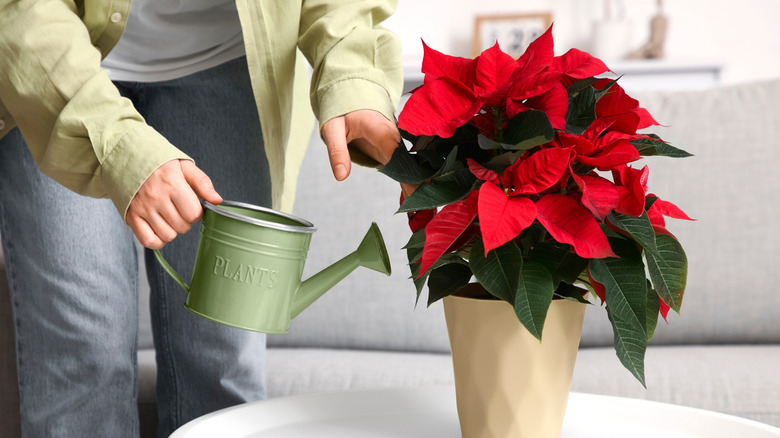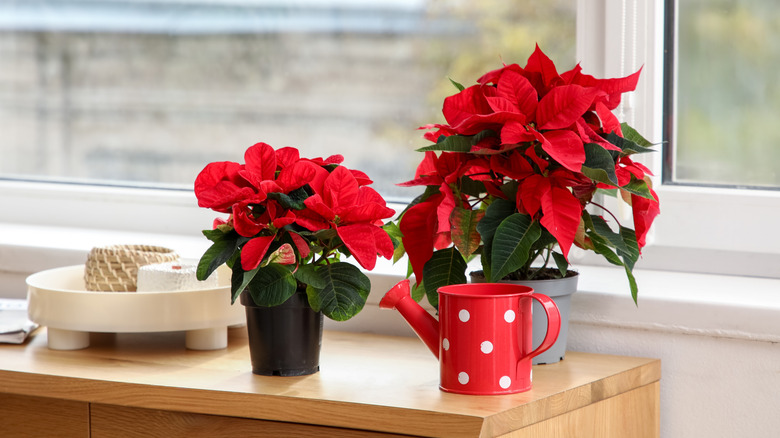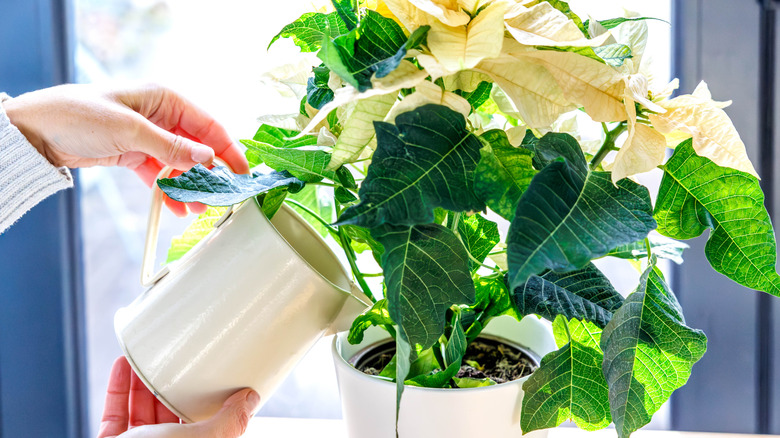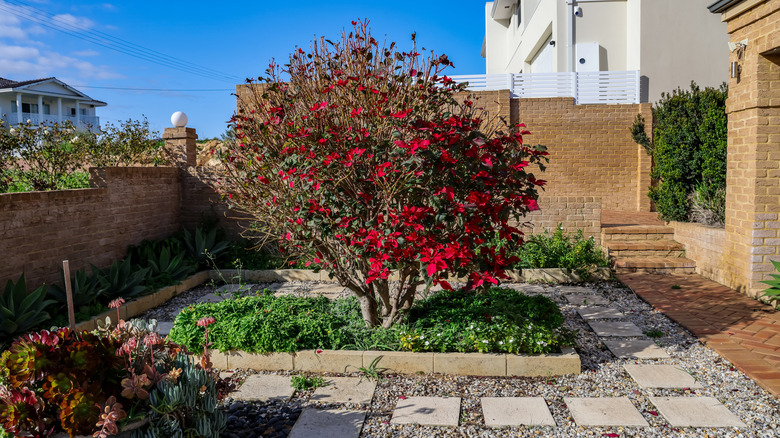How Often Do You Water Poinsettias? Here's How To Keep Them Alive & Healthy
If you grew up around them, poinsettias might evoke mixed feelings for you. On one hand, their green foliage and vibrant red bracts (yep, those are modified leaves, not flowers) say "it's the holidays" more clearly than anything except a light-covered tree. But you might also have a feeling of dread fostered by memories of a grandmother secreting them away in a dark crawlspace to make the poinsettia's leaves turn red, or in a locked room to keep drafts away. And absolutely everyone seemed at odds about how often to water poinsettias. Hunker spoke exclusively with author Hilton Carter, a plant and interior stylist, about keeping poinsettias hydrated, and he told us that it's not as scary as it might seem.
"These beauties thrive on consistent moisture, especially when they're living indoors where the air can get dry," said Carter. In many ways, their water needs are just like those of many other indoor plants. "Let your poinsettias tell you when they're thirsty," he said, outlining the best ways to tell when it's time to give them a drink. He also clued us in to some peculiarities of poinsettias, both in how they react to water and how they handle indoor life, as well as some peculiar ideas about how to best deliver water to them. The upshot is that you should cultivate a relationship with poinsettias, especially if you're growing them indoors. "Just listen to your plant, and it'll reward you with those bold, festive vibes all season long," said Carter.
How often you should water poinsettias, and signs you're overwatering
Rather than watering poinsettias on a schedule, keeping tabs on soil and foliage are more reliable ways to figure out when to break out the watering can. When Hunker spoke exclusively with expert plant stylist Hilton Carter, he told us that the schedule will depend on your plant's environment. "Depending on where your poinsettias are hanging out — sunny window, cozy corner, or near a heat vent — you might find yourself watering them every two to three days," he explained.
Learning what the plant needs is simple. "Give the top inch of soil a little poke — if it feels dry, it's time for a drink," Carter explained, adding that you can look for sure signs of thirst in the soil, the plant itself, or even its pot. A wilting poinsettia is in need of care ... and probably water. "You can tell a poinsettia is thirsty when its leaves begin to curl inward, almost as if they're whispering for a drink. The soil dries out, the pot feels light in your hands, and the plant itself leans, top-heavy and unbalanced," he said.
Carter, the author of five books on styling interiors with plants, has a way with words and poinsettias, so he also knows when one has been a little too generous with the water. Use your senses: is the pot heavier or damper than usual? Can you smell a little mold? "The key is balance. Let the water flow freely through the bottom of the pot, giving the roots what they need without drowning them. Let them breathe," said Carter.
How to properly water your poinsettia plants
Fortunately, there's no arcane secret to watering a poinsettia. When Hunker spoke exclusively with plant expert Hilton Carter, he said that properly watering poinsettias is just like watering most other potted plants. "Give it a deep, thorough soak, letting that water run through and out the drainage hole," he said. "That's how you know it's quenched."
Perhaps because poinsettias sometimes have a reputation for being finicky, some gardeners have developed unusual tricks for getting water to them. One such trick ... using ice cubes ... turns out to not be such a great idea. "Think about it — plants thrive in warm, nurturing environments, and dropping freezing cold ice on their roots? That's a bit of a shock to their system," he said.
Instead of resorting to gimmicks, consider what the plant is likely to get in its native environment. "What your green friends really need is a gentle, even pour of filtered or rainwater — something that mimics what they'd get in nature. That's the kind of drink that reaches deep and keeps them happy, healthy, and growing," said Carter. And that gentleness is important, because splashing water on the leaves can invite mold growth on plants grown indoors without a lot of air movement. Poinsettias are easily found around the holiday season, of course, and that means you might also have to contend with other gimmicks, like packaging that can interfere with proper watering. "If it's wrapped in that decorative foil, be sure to lift it or poke holes so the water doesn't sit and cause root rot," advised Carter.
Tips to keep your poinsettias alive indoors
We often grow plants indoors because they aren't equipped to cope with the climes where we live. The closer you can keep a poinsettia's conditions to what it's used to in the natural world, the happier the plant will be. "Poinsettias, with their vibrant spirit, hail from the warm, sun-kissed landscapes of Mexico. They thrive in dry, temperate conditions — think warm days and just the right touch of humidity," said plant expert and interior stylist Hilton Carter in an exclusive interview with Hunker. "If you can, let them live outside where they can stretch out and soak up the light." And if you can't, the closer you get to their natural environment, the better.
Another aspect of indoor life that poinsettias are unprepared for is being handled by passers-by as they walk through a room and, perhaps, try to get a handle on their water needs. While it's good to use your senses when growing a poinsettia, less direct handling is better than more. "Their leaves are delicate, sensitive to touch, so it's best to admire without handling too much," said Carter.
Ultimately, caring for poinsettias is probably not as fraught with risk as you think. Apply a common amount of sense and gentleness, and they'll reward you year-round. "Whether you grow them indoors or out, they'll wear their green robes most of the year," Carter said, waxing poetic in the way poinsettias can sometimes inspire. "But when the days grow shorter and the light begins to fade, they shift – revealing those iconic reds, pinks, and whites. It's nature's quiet way of saying the seasons are changing."



